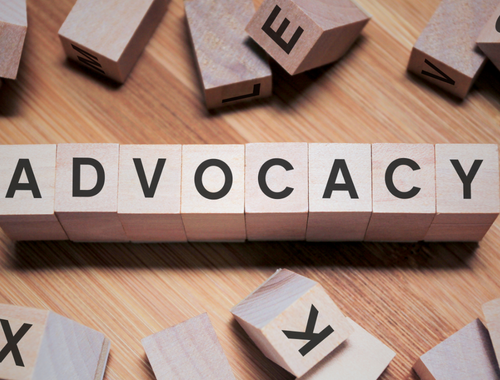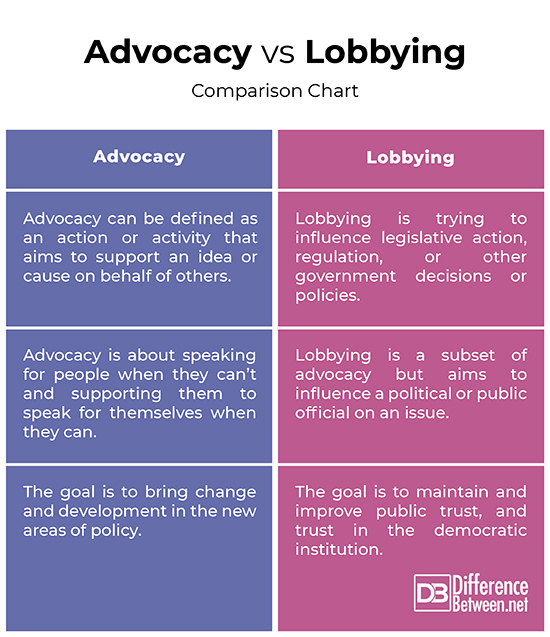Difference Between Advocacy and Lobbying
• Categorized under Language,Words | Difference Between Advocacy and Lobbying
To many people, the terms advocacy and lobbying create some sort of confusion. Because of some overlapping between the two, the lines can easily become blurred. So, it is important to understand the difference between advocacy and lobbying. Lobbying is exciting and honorable work, and so is advocacy. However, advocacy is a vast term that encompasses just about every form of communication. Lobbying, on the other hand, is a narrowly defined activity or you could say ‘advocacy.’ Let’s take a good look at the two and try to understand the differences between them.

What is Advocacy?
Advocacy can be defined as an action or activity that aims to support a cause or idea, whether it’s for environmental protection, minority rights or to raise awareness, influence decision, or a myriad range of activities.
Advocacy means to voice an opinion on behalf of others. It can be defined as the active support of a cause, proposal or policy that aims to benefit a greater cause with a goal to make society a better place.
Advocacy is about helping people find their voice. It is about giving someone support to have their voice heard. The idea is to influence decisions within political, economic, and social institutions.
Advocacy is about speaking for people when they can’t and supporting them to speak for themselves when they can. An advocate can support an individual in many different ways.
The word advocate comes from the Latin word ‘advocatus’ meaning a “pleader on one’s behalf.”

What is Lobbying?
Lobbying is basically advocacy but aims to influence a political or public official on an issue. Lobbying is communicating with any government official or in a quasi-public agency and influencing their actions or decisions. It means trying to influence those in power to pass or eliminate legislation.
Today, most institutions are represented by lobbyists from labor unions and charities to corporations and foreign governments that target policy makers with a view to influencing policy outcomes.
Lobbying is a practice performed by either individuals or organizations or private interest groups to influence laws and regulations at the expense of the public interest. You practice lobbying when you wish to influence a decision which means you’re trying to have a government bill or draft modified, withdrawn or approved.
Lobbyists play a much larger role in American politics; they get politicians elected, bills passed, and national programs funded, and so much more.
Difference between Advocacy and Lobbying
Definition of Advocacy and Lobbying
– Advocacy can be defined as an action or activity that aims to support an idea or cause on behalf of an individual or group to uphold their rights or have their voice heard. Advocacy is about speaking for people when they can’t and supporting them to speak for themselves when they can.
Lobbying, on the other hand, is a subset of advocacy but aims to influence a political or public official on an issue. Lobbying is communicating with someone who makes laws, asking them to change or modify a piece of legislation.
Interest of Advocacy and Lobbying
– Advocacy is to influence decisions within political, economic, and social institutions. It is a process of supporting and helping people to express their views, thoughts and concerns, and ultimately, have their voice heard.
Lobbying, on the other hand, performed by either individuals or organizations or private interest groups to influence laws and regulations at the expense of the public interest. Lobbying is communicating with someone who makes laws.
Goal of Advocacy and Lobbying
Advocacy is about helping people find their voice. The goal is to bring change and development in the new areas of policy, and raise awareness of those issues to influence others to take action. It is the active support of a cause, proposal or policy that aims to benefit a greater cause with a goal to make society a better place.
Lobbying is trying to influence those in power to pass or eliminate legislation. The goal of lobbying is to maintain and improve public trust, and trust in the democratic institution.
Advocacy vs. Lobbying: Comparison Chart

Summary of Advocacy vs Lobbying
In a nutshell, lobbying can be a part of advocacy, but advocacy does not have to include lobbying. Advocacy is to influence decisions within political, economic, and social institutions. Lobbying is attempting to secure the passage, amendment or defeat of any legislation or to influence decisions made by legislative council. Lobbying is communicating with someone who makes laws. Although lobbying is a subset of advocacy, it is not as broad as advocacy.
What is the meaning of lobbying and advocacy?
Advocacy means to voice an opinion on behalf of others and help people to make choices and say what they want. Lobbying is to persuade government officials, legislators, or members of regulatory agencies to influence their decisions.
What are the examples of advocacy and lobbying?
Examples of advocacy can be found at every level from educating people about global poverty to arguing for a cause to national level campaigns, and more. Lobbying examples include meeting with government officials, influencing legislation by negotiating some bill or policy, etc.
What is the importance of advocacy and lobbying?
Influencing policy makers or decision makers is an integral part of a democratic system. Advocates and lobbyists can provide decision makers with valuable insights and information to cover any gaps in knowledge. The idea is to ensure a productive government.
What are the 3 main types of lobbying?
Lobbying can be broadly classified into three main types: direct lobbying, grassroots lobbying, and electoral lobbying.
Outside his professional life, Sagar loves to connect with people from different cultures and origin. You can say he is curious by nature. He believes everyone is a learning experience and it brings a certain excitement, kind of a curiosity to keep going. It may feel silly at first, but it loosens you up after a while and makes it easier for you to start conversations with total strangers – that’s what he said."
- Difference Between Caucus and Primary - June 18, 2024
- Difference Between PPO and POS - May 30, 2024
- Difference Between RFID and NFC - May 28, 2024
Sharing is caring!
Search DifferenceBetween.net :
Cite
APA 7
Khillar, S. (2023, February 11). Difference Between Advocacy and Lobbying. Difference Between Similar Terms and Objects. https://www.differencebetween.net/language/difference-between-advocacy-and-lobbying/.
MLA 8
Khillar, Sagar. "Difference Between Advocacy and Lobbying." Difference Between Similar Terms and Objects, 11 February, 2023, https://www.differencebetween.net/language/difference-between-advocacy-and-lobbying/.
Leave a Response
Written by : Sagar Khillar. and updated on 2023, February 11
References :
[0]Gelak, Deanna. Lobbying and Advocacy: Winning Strategies, Recommendations, Resources, Ethics and Ongoing Compliance for Lobbyists and Washington Advocates. Virginia, United States: TheCapitol.Net Inc., 2008. Print
[1]Pekkanen, Robert J., et al. Nonprofits and Advocacy: Engaging Community and Government in an Era of Retrenchment. Maryland, United States: JHU Press, 2014. Print
See more about : Advocacy, lobbying
